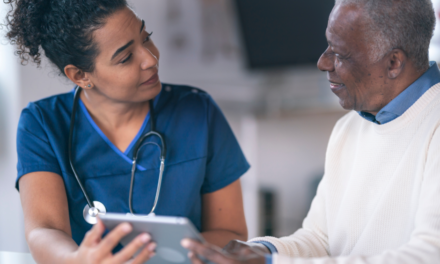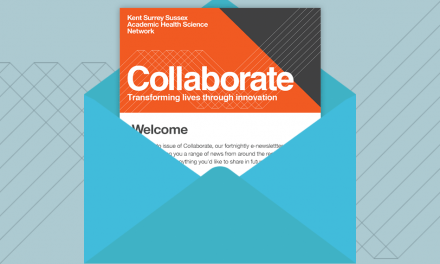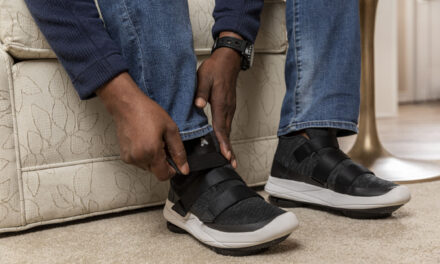Meet Sachin Gohil, Senior Vice-President and Chief Commercial Officer at AposHealth, a leader in the management and prevention of musculoskeletal conditions. The company’s ground-breaking wearable medical device utilises the science of gait modification to enable people with knee, and hip, pain live well in greater comfort – reducing or eliminating the need for surgery.
In this article, Sachin tells us why getting decision makers to listen is the biggest challenge for innovators, why a positive mindset is a vital attribute, and how working across three time zones ensures life is never dull.
Tell us about your innovations – what and why?
Apos provides pain relief and improvement in joint function for, predominantly, patients suffering from knee osteoarthritis so they can get back to doing the things they love: going for a stroll, walking the dog – just going out and living their normal life as they would have done before they were affected by joint pain.
Essentially, Apos is a non-invasive device that improves joint pain and function. However, the key differential with Apos is that we are so effective with our treatment that we can actually delay or avoid joint replacement surgery – and that’s really important given we’re now in a situation where we have such a long backlog of people needing treatment and many patients can face a long wait for surgery.
What was the lightbulb moment?
Apos isn’t new; it’s been around for a while, and the principles it’s based on are well founded – understanding ground reaction force and manipulating patients’ gait.
The thing that Apos does really well, though, is that it combines both a bio-mechanical realignment at the knee joint and a neuromuscular treatment in one device, and it’s the only one of its kind on the market. We have a growing body of evidence for effectiveness and it’s clear the impact Apos has on patients’ lives and the health system.
I’m a clinician by background and have worked with the NHS my entire career, When I joined AposHealth two years ago, looking at our trial data, evidence for effectiveness and the health economics, I couldn’t understand why Apos wasn’t more widely used across the NHS. This is where it started to become more of a mission for me. I felt “this is a no brainer – I don’t understand why we’re not putting this into every knee pain pathway”. At this point I got hooked, and I also became a patient myself.
Although I don’t suffer from osteoarthritis, I have a painful knee from my attempts to run so I started using Apos and was feeling the benefits within six months: it makes a difference – it works. That’s why it became a mission for me – to ensure Apos is used more widely across the NHS.
What’s been your innovator journey highlight to date?
Through HealthTech Connect we were reviewed by NICE as part of a Medtech Innovation Briefing that was published in February and, as part of that, we were also reviewed by the NICE evaluation panel and accepted on to the Medical Technologies Evaluation Programme for a full evaluation. The gap between our MIB and acceptance onto the MTEP was really quick and we’ve a strong body of evidence so confident we will get a good outcome.
For me that’s been an absolute highlight: to get recognition from an organisation like NICE has been really helpful and encouraging.
How has KSS AHSN supported you?
They’ve been very supportive. They’ve been socialising our innovation with their stakeholders across the region, and they’ve also been very cognisant of the timing on when to go out to their partners. It’s not been just a case of pushing it out, waiting for feedback and saying “if we don’t get any response, we’ll put you in our catalogue”. They’ve been aware that people’s attentions are going to be focused elsewhere due to the pandemic. That help with timing has been really important.
They’ve also been able to signpost us to other organisations, such as National Institute for Health Research, and to potential funding opportunities. They’re always there with encouragement and support when things get tough to navigate.
I have a really good dialogue with Charlotte (Roberts) at KSS ASSN. It’s really nice just to check in and say “here’s what we’ve been up to” and she’ll say “Have you thought about this, and by the way we’d love to put you in touch with these people…”
On a more practical level, they’re providing some health economics support through the Unity Insights analytics service – and that’s going to help us with our NICE submission. On the whole, they’ve just been a great sounding board for developing the value proposition. I’ve valued their advice throughout the process.
What has been your toughest obstacle to date?
Getting the system to listen is probably the hardest thing to achieve. Everyone and everything is in a constant state of flux so it’s challenging keeping conversations going during the pandemic, for example, or now that CCGs are forming into ICSs, Much of the time, the decision makers you need to speak to are either not in post or don’t have the capacity to speak to anyone outside their main priorities.
Although we spend a lot of money on MSK as a health system, knee osteoarthritis it’s a life-limiting condition rather than a life-threatening one, so it can fall down the priority list. For example, the system has a huge backlog of patients on the elective orthopaedic surgery waiting list and we have to do something about it. The longer patients wait, the worse their quality of life becomes and, at the moment, there is no alternative for them – this is why Apos is so important.
One solution is to increase surgical capacity, but what if we were also able to reduce the number of patients who needed surgery? This is where Apos can really have an impact. We can save valuable resource and use that to reinvest in other areas, for example improving community MSK services or freeing up staff resource.
It’s tough to navigate the system and get people to hear the impact Apos can make. This is where the AHSN has been so helpful. My mantra has been “how do we make it easy for the system to implement Apos?” Laying the foundations through engaging with the AHSNs, achieving recognition through NICE and being available through NHS Supply Chain will help our cause.
Hopes for the future?
We’ve partnered with Talarmade, an orthotics distributor, so Apos is available via NHS Supply Chain. From our perspective, it’s a question of how we lay the foundation to scale and simply switch on Apos within any organisation.
We know we can have a positive impact on patients’ lives and the health system. For me, the future is a positive NICE recommendation and Apos being a fundamental part of the knee pain pathway.
We want to be part of the Medtech Funding Mandate and to work with the NHS Accelerated Access Collaborative to establish Apos as part of the health system. I also want to be able to work with ICS partners more on how we can implement as the work on why we should use Apos has already been done.
We want to be a great partner for the NHS. The whole Apos team want to be part of making a real difference and that’s what drives us each day.
A typical day for you would include?
The one thing I’m learning about Apos is that every day is different. My main roles are growth and running the business within the UK.
I always have one eye on the pipeline, making sure conversations with ICSs, clinicians and key stakeholders are being progressed. I’m all too aware that it takes time to effect change. I’m also involved in several projects that span the global organisation. We piloted a telemedicine virtual care offering in the UK during the pandemic and we’ve been able to transfer that into the US. That’s really exciting as we can now start to develop more than just our core innovation in terms of our market offering and develop ways we can scale effectively.
I’m also currently involved in mobilising our China operations. We have a clinic in Beijing and will soon open in Shanghai. It’s quite exciting as there’s huge potential for us in that market and it’s an area we’ve not been into before.
One thing I’ve had to learn quickly is how to work effectively across three time zones. My kids are still young so am no stranger to being up early and working late. There’s always something going on, and I really enjoy that.
What’s the best part of your job now?
For me, the team I work with are just so dedicated, passionate and great experts as well. I work with physiotherapists, who are just amazing in how they do what they do. The way they can assess a patient and know what they need just by looking at the way they walk… It’s a great team to be part of and I really enjoy working with them.
My absolute favourite thing, though, is still when I visit a clinic, and I like to do that as often as I can. I sit in on a patient consultation and see the impact that Apos has on their lives. We call this the ‘wow moment’. The patient puts on the calibrated device and they can immediately feel the impact – it’s so emotive, seeing the change.
For me that’s really exciting. It gives you the energy and motivation to keep doing what you do, knowing that we make a difference. That for me is really important – it’s a really enjoyable part of the job.
What three bits of advice would you give budding innovators?
Firstly – don’t give up. You will undoubtedly get knocked back and people may criticise what you’ve got as an offering, and they’ll find holes. If they believe what you’ve got, the holes won’t become that big. If they don’t, they’ll look at whatever you have by way of evidence, and they’ll start to pick it apart. But if you keep the faith, then you’ll achieve your goal. It’s vital to keep a positive mindset.
The second thing is to make it easy – ensure the value proposition is clear and simple. That’s one thing I did when I joined the organisation. It’s important that that you use the evidence you have and accept the gaps and find ways to close them. We are now in a position where our value proposition is strong. Same goes for the implementation: make sure that’s as easy as possible. Again, if it’s on the ‘too hard’ pile, it just gets waylaid or forgotten about. It’s also important to think about the staff impact of what you’re doing. Many innovations are developed around the overall costs of care or releasing efficiencies, and that’s great, but you should ask yourself: how do I make it tangible? What’s the potential impact on staff? This is clearly a topical issue right now – finding ways to help staff who are already burnt out to release capacity so they can breathe or take time off, or perhaps do other things that enable them to add more value.
My final piece of advice is to share – make sure you share your experience with as many people as you can. Speak to other innovators and peers because those are the people who have been there and done that, and they’re your best source of information on how to navigate what can be a really complex system. I feel there’s always an opportunity to collaborate with another innovator. I don’t ever feel like we’re competing with anyone – there’s always a chance to help each other along the journey, whether it’s simply putting someone in touch with someone else or a more formal collaboration around another product that we can offer.
——–
Find out more about AposHealth at www.aposhealth.co.uk and follow them on TWITTER @AposHealthUK / LINKEDIN www.linkedin.com/company/aposhealth
To find out about the support available from Charlotte and our industry engagement team, please get in touch via kssahsn.bridgingthegap@nhs.net





